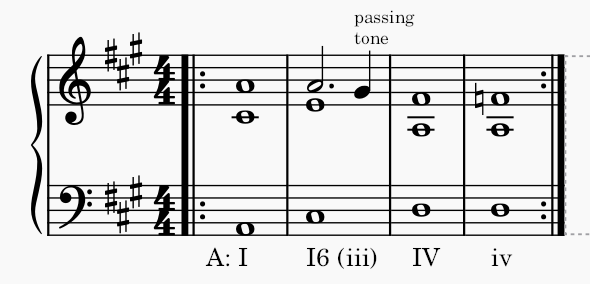I iii IV iv
Some theory ideas to apply...
- In German theory
I and iii both express the tonic
- In functional harmony
I is tonic, iii, IV, and iv are all pre-dominant
iv is the borrowed sudominant chord, it's mode quality changes to minor, but functionally it still is a subdominant- the bass of the segment
iii IV is a half step ascent from scale degree ^3 to ^4, depending on the voice leading it also includes the half step ascent from ^7 to ^1, the leading tone to tonic, both of which have a lot of "pull"
- melodic lines tend to continue movement in the direction of a chromatic alteration
In a typical analysis, or for people who mistakenly think that harmony is derived from the circle of fifths, the progression iii IV doesn't seem to "work" because it isn't root progression by descending fifth. And depending on the voiced leading it can have parallel fifths which isn't allowed in Church style counterpoint. These are the two reasons someone might think theory says iii IV doesn't work.
Assuming all chords are in root position and in your example key of A major we could make one small alteration to iii IV by raising the G# of iii to A and then the progression becomes I6/3 IV which is root progression by descending fifth. Combine this with the German idea that I and iii both express the tonic,
and the strong "pull" you can get from the scale degree movements of iii IV, and you could say the two progressions are roughly analogous. Theoretically you can collapse I iii into simply tonic and I iii IV then is simply tonic subdominant.
Functionally your progression is tonic, pre-dominant, pre-dominant, pre-dominant. There is nothing functionally "wrong" with that. You just don't show what happens next.
Is your progression supposed to repeat? Like this? |: I iii IV iv :\.
If yes, then my two assessments show basically the same thing, the progression loops around from tonic to subdominant. That works just fine.
The part IV iv doesn't really require special attention changing the modal quality of a chord like that is very common. But notice that if it loops back to the tonic IV iv I then the chromatic alteration to the subdominant continues the downward descent. So, in A major, D Dm A contains the chromatically descending line F# F♮ E.
You could says that I iii IV iv is just an elaboration of I IV where the inserted iii provides pull up to IV and iv provides a more emphatic drop down to I. It goes up to the subdominant then it goes down to the tonic.
Despite the potential to mistake iii IV as a "music theory problem", music theory actually will explain very nicely why |: I iii IV iv :| is a satisfying progression.
I forgot, there is another way to "explain" the origin of a iii chord in this progression. It's way easier to show in notation...

If the G# is considered a passing tone over a first inversion I6 it coincidentally forms a root position iii. Technically there is no duration limit on a passing tone. So just play it very long and the iii chord become prominent. That established the sound of root movement I III IV, which is just the roots regardless of voicing details. Dispense with the "learned style", Church music voice leading proprieties, which is what pop music does, and you can play I iii IV iv with some sense of an "origin" or "rationalization" about why the progression "works." It isn't necessary to think this way. It's just a way you could square old counterpoint derived harmony with pop harmony.

